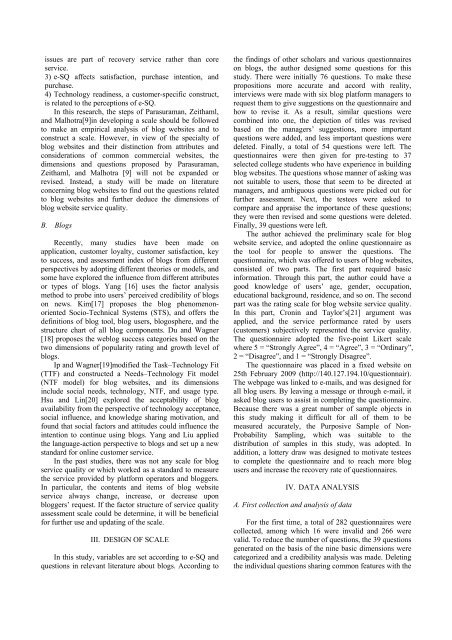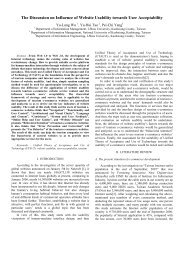Developing a Scale of E-Service Quality for Blog - ResearchGate
Developing a Scale of E-Service Quality for Blog - ResearchGate
Developing a Scale of E-Service Quality for Blog - ResearchGate
You also want an ePaper? Increase the reach of your titles
YUMPU automatically turns print PDFs into web optimized ePapers that Google loves.
issues are part <strong>of</strong> recovery service rather than core<br />
service.<br />
3) e-SQ affects satisfaction, purchase intention, and<br />
purchase.<br />
4) Technology readiness, a customer-specific construct,<br />
is related to the perceptions <strong>of</strong> e-SQ.<br />
In this research, the steps <strong>of</strong> Parasuraman, Zeithaml,<br />
and Malhotra[9]in developing a scale should be followed<br />
to make an empirical analysis <strong>of</strong> blog websites and to<br />
construct a scale. However, in view <strong>of</strong> the specialty <strong>of</strong><br />
blog websites and their distinction from attributes and<br />
considerations <strong>of</strong> common commercial websites, the<br />
dimensions and questions proposed by Parasuraman,<br />
Zeithaml, and Malhotra [9] will not be expanded or<br />
revised. Instead, a study will be made on literature<br />
concerning blog websites to find out the questions related<br />
to blog websites and further deduce the dimensions <strong>of</strong><br />
blog website service quality.<br />
B. <strong>Blog</strong>s<br />
Recently, many studies have been made on<br />
application, customer loyalty, customer satisfaction, key<br />
to success, and assessment index <strong>of</strong> blogs from different<br />
perspectives by adopting different theories or models, and<br />
some have explored the influence from different attributes<br />
or types <strong>of</strong> blogs. Yang [16] uses the factor analysis<br />
method to probe into users’ perceived credibility <strong>of</strong> blogs<br />
on news. Kim[17] proposes the blog phenomenonoriented<br />
Socio-Technical Systems (STS), and <strong>of</strong>fers the<br />
definitions <strong>of</strong> blog tool, blog users, blogosphere, and the<br />
structure chart <strong>of</strong> all blog components. Du and Wagner<br />
[18] proposes the weblog success categories based on the<br />
two dimensions <strong>of</strong> popularity rating and growth level <strong>of</strong><br />
blogs.<br />
Ip and Wagner[19]modified the Task–Technology Fit<br />
(TTF) and constructed a Needs–Technology Fit model<br />
(NTF model) <strong>for</strong> blog websites, and its dimensions<br />
include social needs, technology, NTF, and usage type.<br />
Hsu and Lin[20] explored the acceptability <strong>of</strong> blog<br />
availability from the perspective <strong>of</strong> technology acceptance,<br />
social influence, and knowledge sharing motivation, and<br />
found that social factors and attitudes could influence the<br />
intention to continue using blogs. Yang and Liu applied<br />
the language-action perspective to blogs and set up a new<br />
standard <strong>for</strong> online customer service.<br />
In the past studies, there was not any scale <strong>for</strong> blog<br />
service quality or which worked as a standard to measure<br />
the service provided by plat<strong>for</strong>m operators and bloggers.<br />
In particular, the contents and items <strong>of</strong> blog website<br />
service always change, increase, or decrease upon<br />
bloggers’ request. If the factor structure <strong>of</strong> service quality<br />
assessment scale could be determine, it will be beneficial<br />
<strong>for</strong> further use and updating <strong>of</strong> the scale.<br />
III. DESIGN OF SCALE<br />
In this study, variables are set according to e-SQ and<br />
questions in relevant literature about blogs. According to<br />
the findings <strong>of</strong> other scholars and various questionnaires<br />
on blogs, the author designed some questions <strong>for</strong> this<br />
study. There were initially 76 questions. To make these<br />
propositions more accurate and accord with reality,<br />
interviews were made with six blog plat<strong>for</strong>m managers to<br />
request them to give suggestions on the questionnaire and<br />
how to revise it. As a result, similar questions were<br />
combined into one, the depiction <strong>of</strong> titles was revised<br />
based on the managers’ suggestions, more important<br />
questions were added, and less important questions were<br />
deleted. Finally, a total <strong>of</strong> 54 questions were left. The<br />
questionnaires were then given <strong>for</strong> pre-testing to 37<br />
selected college students who have experience in building<br />
blog websites. The questions whose manner <strong>of</strong> asking was<br />
not suitable to users, those that seem to be directed at<br />
managers, and ambiguous questions were picked out <strong>for</strong><br />
further assessment. Next, the testees were asked to<br />
compare and appraise the importance <strong>of</strong> these questions;<br />
they were then revised and some questions were deleted.<br />
Finally, 39 questions were left.<br />
The author achieved the preliminary scale <strong>for</strong> blog<br />
website service, and adopted the online questionnaire as<br />
the tool <strong>for</strong> people to answer the questions. The<br />
questionnaire, which was <strong>of</strong>fered to users <strong>of</strong> blog websites,<br />
consisted <strong>of</strong> two parts. The first part required basic<br />
in<strong>for</strong>mation. Through this part, the author could have a<br />
good knowledge <strong>of</strong> users’ age, gender, occupation,<br />
educational background, residence, and so on. The second<br />
part was the rating scale <strong>for</strong> blog website service quality.<br />
In this part, Cronin and Taylor’s[21] argument was<br />
applied, and the service per<strong>for</strong>mance rated by users<br />
(customers) subjectively represented the service quality.<br />
The questionnaire adopted the five-point Likert scale<br />
where 5 = “Strongly Agree”, 4 = “Agree”, 3 = “Ordinary”,<br />
2 = “Disagree”, and 1 = “Strongly Disagree”.<br />
The questionnaire was placed in a fixed website on<br />
25th February 2009 (http://140.127.194.10/questionnair).<br />
The webpage was linked to e-mails, and was designed <strong>for</strong><br />
all blog users. By leaving a message or through e-mail, it<br />
asked blog users to assist in completing the questionnaire.<br />
Because there was a great number <strong>of</strong> sample objects in<br />
this study making it difficult <strong>for</strong> all <strong>of</strong> them to be<br />
measured accurately, the Purposive Sample <strong>of</strong> Non-<br />
Probability Sampling, which was suitable to the<br />
distribution <strong>of</strong> samples in this study, was adopted. In<br />
addition, a lottery draw was designed to motivate testees<br />
to complete the questionnaire and to reach more blog<br />
users and increase the recovery rate <strong>of</strong> questionnaires.<br />
IV. DATA ANALYSIS<br />
A. First collection and analysis <strong>of</strong> data<br />
For the first time, a total <strong>of</strong> 282 questionnaires were<br />
collected, among which 16 were invalid and 266 were<br />
valid. To reduce the number <strong>of</strong> questions, the 39 questions<br />
generated on the basis <strong>of</strong> the nine basic dimensions were<br />
categorized and a credibility analysis was made. Deleting<br />
the individual questions sharing common features with the




